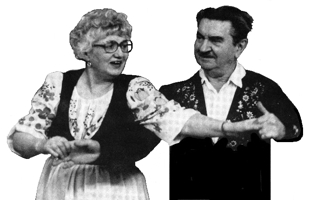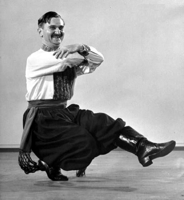
|
The Society of Folk Dance Historians (SFDH) Michael and Mary Ann Herman
Home |
About |
Encyclopedia | CLICK IMAGE TO ENLARGE |

|
BACKGROUND
Information: Michael Herman (1911-1996) and Mary Ann Bodnar Herman (1912-1992), teachers and authors of international dance.
Michael was born in 1911 and arrived in New York in 1930 (although The Folk Dancer magazine, in its first issue, says that "he was born in Cleveland, Ohio, and spent the greater part of his life among immigrant groups." He was trained in Ukrainian dance by Vasilľ Avramenko and classical violin at the Juilliard faculty. In 1931, folk dancing was limited to ethnic groups in New York. Michael became acquainted with these groups through playing the violin, and acquired a wide knowledge of the music and dances from many countries. Gaining status as a folklorist, he began teaching at the New School for Social Research and founded the Folk Council of New York.
By that time, Mary Ann Bodnar, born 1912 in New York City to immigrant Ukrainian parents, was also teaching folk dancing. Her early life was spent in the Ukrainian neighborhood. She later attended James Monroe High School. Although she used to be a performer in a Ukrainian group, and had started teaching those dances in places such as the YWCA, she said that her career as a folk dance teacher was really launched when she married Michael and became Mary Ann Herman. Michael and Mary Ann performed in Avramenko's Ukrainian Ensemble and were a part of a Folk Festival Council which invited Michael to lead folk dancing on the American Common at the 1939 New York World's Fair. Some 1,500 people had put their names on Michael's contact list.
 On October 15, 1940, the Hermans opened a folk dance center in the Ukrainian National Home on East 6th Street. Although the original turnout was disappointing (only 16 of 1,500 showed up), attendance grew and Folk Dance House became known throughout the folk dance world. From a weekly class, the center grew to daily classes, workshops, teacher-training courses, and festivals. They moved to Polish Dom, and finally found a building on 16th Street at 6th Avenue where they opened their soon-to-be-famous Folk Dance House. Everyone from dancer to musician was always welcome at Folk Dance House. Attendees included Burl Ives, Gene Kelly, Peter Lorre, and Damon Runyon. Andor Czompo created a dance in tribute to Mr. Herman, naming it Michael's Csárdás. Michael was a featured personality in a Rek-O-Kut Company's advertisement for their Rythmaster phonograph, which said "Michael Herman, Editor of Folk Dance Magazine and one of America's foremost Teachers of Folk Dancing."
On October 15, 1940, the Hermans opened a folk dance center in the Ukrainian National Home on East 6th Street. Although the original turnout was disappointing (only 16 of 1,500 showed up), attendance grew and Folk Dance House became known throughout the folk dance world. From a weekly class, the center grew to daily classes, workshops, teacher-training courses, and festivals. They moved to Polish Dom, and finally found a building on 16th Street at 6th Avenue where they opened their soon-to-be-famous Folk Dance House. Everyone from dancer to musician was always welcome at Folk Dance House. Attendees included Burl Ives, Gene Kelly, Peter Lorre, and Damon Runyon. Andor Czompo created a dance in tribute to Mr. Herman, naming it Michael's Csárdás. Michael was a featured personality in a Rek-O-Kut Company's advertisement for their Rythmaster phonograph, which said "Michael Herman, Editor of Folk Dance Magazine and one of America's foremost Teachers of Folk Dancing."
Michael Herman's Folk Dance Orchestra was a featured group on many of the folk dance recordings that Folk Dance House put out through Sonart Records on the Folk Dancer label, which he co-founded with Dave Rosenberg. Several hundred excellent folk and contra dance recordings were produced, frequently with himself on violin, Mary Ann on piano, and the extraordinary Walter Erickson on accordion.
During World War II, Michael entered the Armed Forces and Mary Ann led the sessions at Folk Dance House. She taught children's daytime classes in folk dancing and arts and crafts. She collected folk art, authentic costumes, and ethnic literature. After Michael's return, he resumed teaching, making records, and writing folk dance books. The couple began teacher training courses which started many folk dance teachers on their way. In addition to their weekly folk dance sessions, the Hermans also occasionally conducted family folk dancing on Sundays. They incorporated a year-end Festival and Workshop into their schedule, with Dick Crum being among the first of the workshop leaders. Others included Michel Cartier, Andor Czompo, David Henry, Çavit Kangõz, Yves Moreau, Ralph Page, and Dave Rosenberg. In the 1970s, Dick Oakes taught for Mary Ann's class.
Interest in international folkdance spread beyond the United States when the U.S. State Department sent the Hermans, Nelda Drury, Jane Farwell, and Ralph Page on a tour of nineteen Japanese cities in 1956. The tour, exposed 21,000 Japanese, including Prince Mikasa, to folk dancing. Jane Farwell (of Folklore Village Farm) and the Hermans further triggered the expansion of interest in folkdancing by creating folkdance camps throughout the East, including, in 1951, the famed Maine Folk Dance Camp. In 1962, Dick Crum and Gordon "Gordy" Engler wrote the Hungarian Waltz Quadrille which appeared in a spoof edition of the Pioneer Press, edited by Ralph Page for the Maine Folk Dance Camp. Dick and Gordy wrote take-offs on every section of the Pioneer Press, then substituted their own mimeographed versions for the originals that everyone found at their tables at breakfast!
Interestingly, when the Moiseyev Dance Company first performed in New York, they visited Folk Dance House to learn American dances! In 1980, the Lincoln Center Library and Museum of the Performing arts in New York was host to an exhibition of authentic folk costumes from around the world. The international celebration was to honor Michael and Mary Ann (from whose collection they used some 35 folk costumes) who had done so much to keep alive America's ethnic traditions.
In 1994, Michael closed the Maine Folk Dance Camp, having become dismayed over perceived mismanagement, disrespect of primary-source dance teachers, record piracy, and the replacement of folk dances with novelty dances. At a new site in 1995, under the direction of folks from whom Michael had distanced himself, began Mainewoods Dance Camp. In 2002, the Mainewoods camp returned to the original camp site (the property had been sold and is now known as Camp Manasseh).
Beginning in the late 1960s, the availability of easily recorded tape cassettes brought on the destruction of the folk dance record industry, including the Folk Dancer label. Because of these feelings, he refused to sell records from his alleged stock of 50,000 Folk Dancer records for the last twenty years of his life. Since Michael's death in 1996, the Kentucky Dance Foundation, under the guidance of Stew Shacklette, became the owner of 71,00 pounds of the Folk Dancer record label, and put the recordings out in CD form.
Mary Ann taught in various camps and workshops across the United States until her death in on March 24, 1992. Michael passed away on Friday, May 10, 1996, in North Shore Hospital in Glen Cove, Long Island. He was 85.
PUBLICATIONS
- The Folk Dancer, a magazine published by Michael Herman. Described by Vyts Beliajus as containing "excellent material covering the folk dance field and related subjects."
- Folk Dances for All. Herman, Michael, comp. and arr. New York: Barnes and Noble, 1947. Instructions for 19 dances from 15 countries. Illustrated. (Everyday Handbook Series).
- "Folk Dance Sounds," by Herman, Mary Ann, in International Encyclopedia of Dance, vol.3, p.38-9.
- Folk Dance Syllabus #1. Herman, Michael. New York: Folk Dance House, 1953. instructions for 70 dances, 15 contras, 7 squares, folk meals, folk parties, and folk decorations used at Maine Folk Dance Camp in 1953.
- Pioneer Press (Maine Folk Dance Camp Syllabus). Herman, Michael and Mary Ann. 1954-1994. Have 69, 89-93.
- Rosin the Bow, 4:1, p.: Kokietka, by Herman, Mary Ann.
- "Vasiľ Avramenko – as I knew him," Herman, Mary Ann. in Ukrainian Folk Dance: A Symposium, Number 1. Toronto: Ukrainian National Youth Federation of Canada, 1961, p. 16-24.
DOCUMENTS
- Folk Dance House, a coffeehouse.
- Folk Dancer, a magazine.
- Folk Dancer Record Service, a recording company.
This page © 2018 by Ron Houston.
Please do not copy any part of this page without including this copyright notice.
Please do not copy small portions out of context.
Please do not copy large portions without permission from Ron Houston.